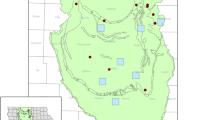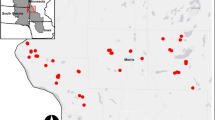Abstract
This project was designed to: (1) document the distribution and migration of organochlorine pesticide residues within marsh substrates of 18 St. Lucie County mosquito control impoundments located along the Indian River Lagoon estuary, and (2) evaluate the impact of water management techniques on residue mobility. Our results indicate that detectible concentrations of organochlorine compounds, applied between the late 1940s and early 1950s, are present in 16 of the 18 St. Lucie County mosquito control impoundments. These compounds are primarily restricted to the surficial, organic-rich wetland sediment, which, based upon geotechnical analysis, was exposed to the atmosphere at a time when the impoundments were subjected to pesticide treatment. Contaminated sediments are present below the surficial, organic-rich layer, suggesting that some vertical migration of pesticides has occurred. It is unlikely that leaching associated with the downward percolation of impounded water was responsible for this migration as pesticide residues were never detected within thein situ pore waters. An alternative explanation is that biological processes (e.g., rooting, burrowing) facilitated the downward flux of organochlorine compounds into sediment horizons not subjected to direct treatment. Eighty-eight surface water samples obtained from two impoundments subjected to contrasting water management techniques were analyzed for pesticide content. None of the surficial water samples collected in association with these impoundments contained detectible concentrations of organochlorine compounds. These samples were unfiltered and contained as much as 25 mg/1 of particulate organic matter. This suggests that the currently preferred management technique (RIM), which is designed to maintain water quality, limit mosquito production, and provide for ecological continuity, does not hydraulically mobilize pesticide residues into the Indian River Lagoon estuary.
Similar content being viewed by others
References
Cox LJ (1971a) DDT residues in seawater and particulate matter in the California current system. Fish Bull 69:443–450
Cox LJ (1971b) Uptake, assimilation, and loss of DDT residues byEuphausia pacifica, a euphausiid shrimp. Fish Bull 69:627–633
Cox LJ (1972) DDT residues in marine phytoplankton. Res Rev 44:23–38
Dean WE Jr (1974) Determination of carbonate and organic matter in calcareous sediments and sedimentary rocks by loss on ignition: Comparison with other methods. J Sediment Petrol 44:242–248
Edwards CA (1973) Pesticide residue in soil and water. In: Edwards CA (Ed), Environmental pollution by pesticides. New York: Plenum Press, 409 pp
Harrington RW Jr and Bidlingmayer WL (1958) Effects of dieldrin on fishes and invertebrates of a salt marsh. J Wild Manage 22:76–82
Harvey GR (1974) DDT and PCB in the Atlantic. Oceanis 18:18–23
Harvey GR, Miklas HP, Bowen VT and Steinhauer WG (1974) Observations on the distribution of chlorinated hydrocarbons in Atlantic Ocean organisms. J Mar Res 32:103–118
Kolipinski MC, Hinger AL, and Yates ML (1971) Organochlorine insecticide residues in Everglades National Park and Loxahatchee National Wildlife Refuge, Florida. Pestic Monit J 5:281–288
Law LM and Goerlitz DR (1979) Microcolumn Chromatographic cleanup for the analysis of pesticides in water. J AOAC 53:1276–1281
Lennard RW (1952) Annual report, St. Lucie County Mosquito Control District. Open file report, pp 56–57
McEwen FL and Stephenson GR (1979) The use and significance of pesticides in the environment. New York: John Wiley & Sons, 538 PP
Mills PA, Bong BA, Kanps LR and Burke JA (1972) Elution solvent system for florisil column cleanup in organochlorine pesticide residue analysis. J AOAC 55:39–43
Seba DB and Corcoran EF (1969) Surface slicks as concentrations of pesticides in the marine environment. Pestic Monit J 3:190–193
USEPA (US Environmental Protection Agency) (1971) Methods for organic pesticides in water and wastewater. Cincinnati, OH: National Environmental Research Center
USEPA (US Environmental Protection Agency) (1986) Test methods for evaluating solid wastes, method 3540. Lab Manual, v. WASTES, SW-846
Wang TC, Johnson RS and Krivan JD (1983) Residues of polychlorinated biphenyls and DDT residues in water and sediment of the St. Lucie Estuary, Florida. J Pestic Monit 13:69–71
White JR (1992) Geological evolution of two backbarrier mangrove swamps, St. Lucie County, Floridas. Unpublished MS thesis. Florida Institute of Technology, 108 pp
Wright L (1977) Troubled waters.New Times 13 March: 27–43
Author information
Authors and Affiliations
Rights and permissions
About this article
Cite this article
Parkinson, R.W., Wang, T.C., White, J.R. et al. Distribution and migration of pesticide residues in mosquito control impoundments St. Lucie County, Florida, USA. Geo 22, 26–32 (1993). https://doi.org/10.1007/BF00775281
Received:
Accepted:
Issue Date:
DOI: https://doi.org/10.1007/BF00775281




